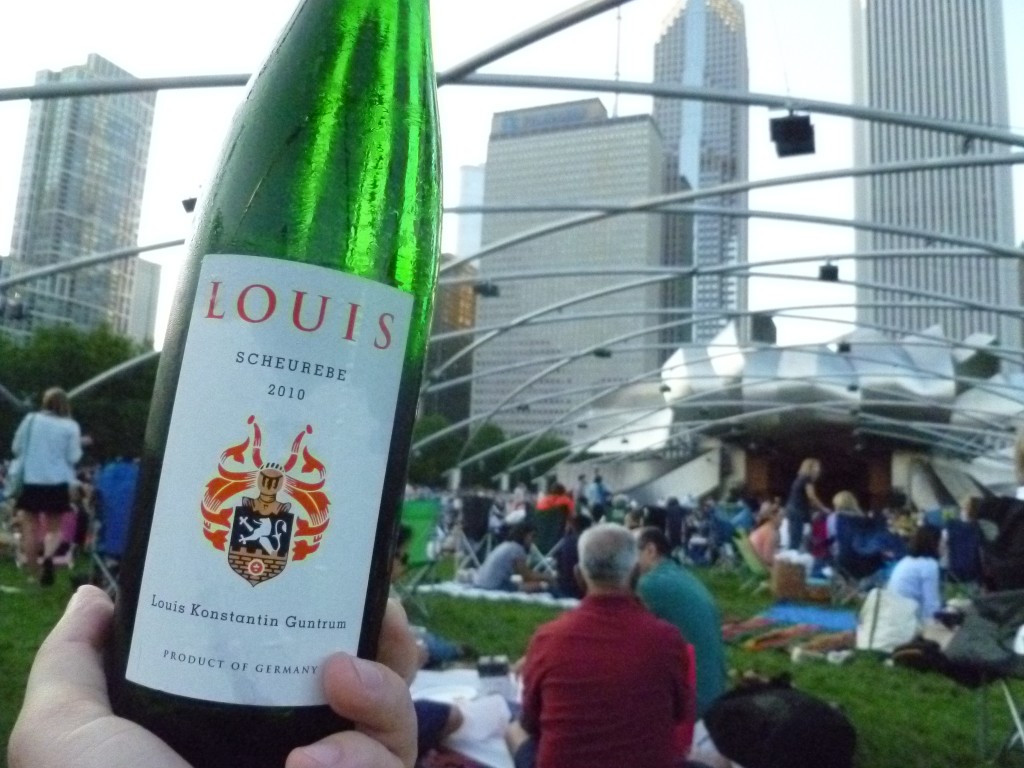A Cross Of Riesling And Whoops!
 I’ve been excited to try more Scheurebe ever since I had an Austrian Beerenauslese version (Beerenauslese indicates a very, very high level of ripeness in the grapes). This variety intrigues me; according to The Oxford Companion to Wine, it’s “the one early 20th-century German crossing that deserves attention from any connoisseur.” But what constitutes that crossing is a bit of a mystery.
I’ve been excited to try more Scheurebe ever since I had an Austrian Beerenauslese version (Beerenauslese indicates a very, very high level of ripeness in the grapes). This variety intrigues me; according to The Oxford Companion to Wine, it’s “the one early 20th-century German crossing that deserves attention from any connoisseur.” But what constitutes that crossing is a bit of a mystery.
Dr. Georg Scheu intended to cross Silvaner with Riesling, in order to produce a more productive version of Riesling (according to the Oxford Companion) or to produce a superior version of Silvaner (according to Wikipedia). Let us hope it was the first, because DNA analysis in the 1990s discovered that the cross has no Silvaner in it whatsoever. The Riesling is there, but the other parent in the cross has yet to be determined. Some speculate that it’s a wild variety Dr. Scheu had been experimenting with. The noble Riesling crossed with some sort of untamed table grape? Gott in Himmel!
Whatever he ended up crossing, Scheurebe (SHOI-ray-beh) seems to work quite well, though only if allowed to thoroughly ripen. The Sotheby’s Wine Encyclopedia warns that Scheurebe “is not very pleasant at Qualitätswein level, but develops a beautiful aromatic character at higher levels of Prädikatswein.” The Oxford Companion agrees, calling it “distinctly unappetizing if picked too early.” But when handled properly, the Oxford Companion continues, Scheurebe can do a fine job in reflecting the specifics of its terroir.
I hoped for the best with 2010 Louis Guntrum Scheurebe Qualitätswein from Rheinhessen, the sandy terroir south of Mainz for which Scheurebe was developed in the first place. It didn’t have the ripeness level recommended by any of my sources, but In Fine Spirits, the wine shop where I found this wine, almost never steers me wrong. I needed something German to pair with the Beethoven playing in Grant Park one evening, and brought it along.
My concert companions seemed to enjoy the wine, though one remarked, “It does its business and it skitters off.” Certainly not condemnation, but not high praise, either. I sniffed it with some suspicion, but the fresh, apply aroma mixed with something tropical drew me right in. On the palate, it started sweet and apply before showing a distinct prickle on the tongue. It was almost sparkling. As it developed, it became more and more tart, with grapefruity acids, until it resolved into a tight finish.
This Scheurebe was a little too acidic for my taste, but at only 10.5% alcohol, it was easy and fun to drink. It certainly felt refreshing in the heat. Interested to see what Louis Guntrum had to say about this wine, I searched the winery’s website for information. I discovered many interesting things, including that the winery, set on the banks of the Rhein near the famed wine town of Nierstein, dates back to 1648, and that the current owner, Louis Konstantin Guntrum, is the 11th generation to lead the winery. Unfortunately, I found nary a peep about Scheurebe.
The importer’s website was little better, not even mentioning Scherebe in the list of varieties grown by Louis Guntrum. I could find no information about it at all; only images of a Scheurebe label and a Scheurebe bottle.
So I’m not sure what Louis Guntrum was going for with this Scheurebe, but I can tell you that it’s worth trying if you come across a bottle. If you find a sweeter version, by all means, buy it! The drier versions, such as the one described above, won’t appeal to everyone, but if you enjoy Portuguese Vinho Verde, for example, this will be right up your alley.
SUMMARY
2010 Louis Guntrum Scheurebe: A little sweet, a little sparkly, and quite acidic. A fun, easy-to-drink wine for the summer, like a sweeter version of Portuguese Vinho Verde.
Grade: B-
Find It: I purchased this wine at In Fine Spirits for $11.50.





